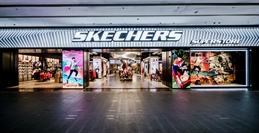
Business is good for Skechers, the performance goods retailer headquartered in Manhattan Beach, California. In fact, this year, the 26-year-old company achieved US$5 billion in worldwide revenues. Since 2014, the American lifestyle and performance footwear company has grown three times.
In Europe, sales have taken off thanks to its established brand and overall growth of the European economy.
“No other footwear company is growing like us,” says Sophie Houtmeyers, vice president of distribution operations for Skechers in Belgium.
Houtmeyers notes that the company’s business in Europe is not impacted by the trade wars between the US and China – but its business in China is also growing. In fact, she reveals that currently for the company overall, Skechers sees its highest growth in sales in China.
China plays an especially important role for the company given that Skechers imports the lion’s share of its goods from China, along with some from Vietnam. The supply chain is managed in the United States with several distribution locations around the globe managed differently according to their territorial characteristics and sales.
“In Russia, we use a distributor,” she said. “In Brazil we still use a 3PL because there is not enough volume to do the work with our own people. In Dubai we use a distributor and have a franchise,” she said.
“Part of our success, worldwide, is due to the fact that our production is directed from the United States,” she said. “We know in advance how much to ship to Europe.”
Skechers has operated its European distribution centre from Liège since 2002. The location was primarily chosen because of available land, proximity to customers and ample skilled logistics workforce. In 2002, the DC was approximately 270,000 square feet. “Now at nearly 1.3 million square feet, it is the largest DC in the south of Belgium,” she said.
While companies have located a wide range of DCs in the Netherlands to be in close proximity to the Port of Rotterdam, Houtmeyers points out that the Netherlands had a shortage of workers. “In Wallonia, there were many people who had lost their job due to the downsizing of heavy industry [decades ago], and therefore shifted from steel to other industries such as logistics.”
For the European market, imported goods come via Belgium’s Port of Antwerp by boat and to the DC mainly by road. Some are sent via barge to Trilogiport, a multimodal maritime and logistics platform operated by the Port of Liège in Belgium’s Wallonia city of Liège.
DP World operates its 15-hectare DP Liège Container Terminal there. The Jost Group and WDP also have facilities at Trilogiport.
“We only just started using Trilogiport, which is located 15 minutes from Skechers,” said Houtmeyers, who is also chairman of Logistics in Wallonia, a trade group promoting the region. “Most shipments still go via road but as of early April, the company has shipped 20 container loads via Trilogiport.
For years bridge heights have delayed the use of barge service on Europe’s inland waterways. “This was a major issue in Belgium which nowadays is solved almost completely,” Houtmeyers said.
With mandates to become more environmentally proactive, Skechers supports “lean and green” efforts and, as Houtmeyers said, “the possibility to have containers delivered closer to our warehouse.”
While Germany and the United Kingdom are Skechers’ two largest European markets, the company ships to Spain, Italy, France, across the Benelux and all other European countries.
“For the last two years, sales have been going up percentage-wise in Spain, Italy and France – sometimes bigger than the UK and Germany,” she said.
All European shipments come from the Skechers DC in Liège. Shipments to the UK travel via short sea from Belgium’s Port of Zeebrugge, which is only about one and one-half hours from Liège.
When asked what impact the Brexit might have on the business, Houtmeyers said: “We, as a region and a company, are prepared but everything depends on Britain’s final vote. Of course, clearing customs will be the challenge in the UK. Additionally, shipments to Ireland will have to transit via the UK and for us, that means adding a transit document.”
Regarding other transport options, Houtmeyers said that the company’s supply chain team in the United States is looking at the option of using the direct train service from Zhengzhou in central China to Liège which commenced in October last year. The service is a block train route added to the Belt and Road network between Europe and China, offering two weekly departures between the hubs, with no stops on route.
“By year’s end, three trains per week – both directions – will be placed on the route,” says Bernard Piette, general manager of Logistics in Wallonia. The journey takes 14-16 days, operated by Chinese conglomerate Zhengzhou International Hub Development and Construction Co, Ltd. (ZIH).
“The cost by train is still higher than ocean,” Houtmeyers said. “That’s the tradeoff but is worth considering.”
The China-Liège block train is only one segment of big changes that are ahead for the region. Alibaba Group – a Chinese multinational conglomerate specializing in e-commerce, retail, internet and technology – is opening a logistics hub at Liège Airport where it is expected to commence operations in early 2021. While Houtmeyers emphasizes that Alibaba represents a different segment of logistics (e-commerce), it could result in other Chinese companies locating in Liège and Wallonia.
“Today, our primary focus is fashion and performance wear,” she said, “along with our vast range of walking, running and golf footwear and apparel.”
An increase in retail stores worldwide is having a huge impact on Skechers’ sales. “Among others, Japan is booming,” she said. And with sales worldwide at an all-time high, Houtmeyers emphasizes: “Production and distribution need to step up, speed up.”
By Karen E. Thuermer
Correspondent | Washington




